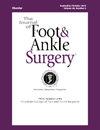采用镍钛诺钉钉和双螺钉构造技术改良Lapidus手术。
IF 1.3
4区 医学
Q2 Medicine
引用次数: 0
摘要
采用第一跗跖骨(TMT)关节融合术矫正拇外翻(HV)畸形有多种固定方法,每种方法各有利弊。很少有人考虑使用由镍钛诺制成的SMA(形状记忆合金)订钉进行固定。本研究评估了使用镍钛诺(形状记忆合金)钉钉结合双螺钉结构的改良Lapidus技术在第一跗跖骨(TMT)关节融合术中矫正拇外翻(HV)畸形的有效性。评估了骨不愈合率、靴和鞋的负重时间、固定钉的拆除以及翻修手术的必要性。对42例符合纳入标准的患者进行回顾性分析,平均随访时间为12.3个月(SD 4.5)。48例患者中47例(97.92%)骨愈合,骨不愈合率为2.08%。穿靴子到负重的平均时间为27.35天(SD 3.47),穿鞋子到负重的平均时间为55.58天(SD 10.03)。共有3例手术需要拆除钉钉(3/48)(6.25%),没有因矫形丢失或不愈合而需要翻修手术。这些结果表明,镍钛诺钉和双螺钉结构是拇外翻畸形第一跗跖关节融合术的可靠选择,与其他固定方法相比,结果相似。临床证据等级:4。本文章由计算机程序翻译,如有差异,请以英文原文为准。
Modified Lapidus procedure with a nitinol staple and two screw construct technique
Many fixation options exist for correction of a hallux valgus deformity with a first tarsometatarsal joint arthrodesis with pros and cons to each. Few have looked at utilizing a shape memory alloy staple made from nitinol for fixation. This study evaluates the effectiveness of a modified Lapidus technique using a nitinol (shape memory alloy) staple combined with a two-screw construct for first tarsometatarsal joint arthrodesis in correcting hallux valgus deformity. The non-union rate, time to weightbearing in both a boot and a shoe, hardware removal of the staples, and the need for revision surgeries were all evaluated. A retrospective review of 42 patients meeting the inclusion criteria was conducted, with an average follow-up time of 12.3 months (SD 4.5). Bony union was achieved in 47 of 48 (97.92 %) cases for a non-union rate of 2.08 %. The average time to weightbearing in a boot was 27.35 days (SD 3.47), while in a shoe, it was 55.58 days (SD 10.03). There was a total of 3 procedures requiring staple removal (3/48) (6.25 %), and no revision surgeries were needed due to loss of correction or non-union. These outcomes suggest that the nitinol staple and two-screw construct is a reliable option for first tarsometatarsal joint arthrodesis in hallux valgus deformity, showing similar results compared to other fixation methods.
求助全文
通过发布文献求助,成功后即可免费获取论文全文。
去求助
来源期刊

Journal of Foot & Ankle Surgery
ORTHOPEDICS-SURGERY
CiteScore
2.30
自引率
7.70%
发文量
234
审稿时长
29.8 weeks
期刊介绍:
The Journal of Foot & Ankle Surgery is the leading source for original, clinically-focused articles on the surgical and medical management of the foot and ankle. Each bi-monthly, peer-reviewed issue addresses relevant topics to the profession, such as: adult reconstruction of the forefoot; adult reconstruction of the hindfoot and ankle; diabetes; medicine/rheumatology; pediatrics; research; sports medicine; trauma; and tumors.
 求助内容:
求助内容: 应助结果提醒方式:
应助结果提醒方式:


